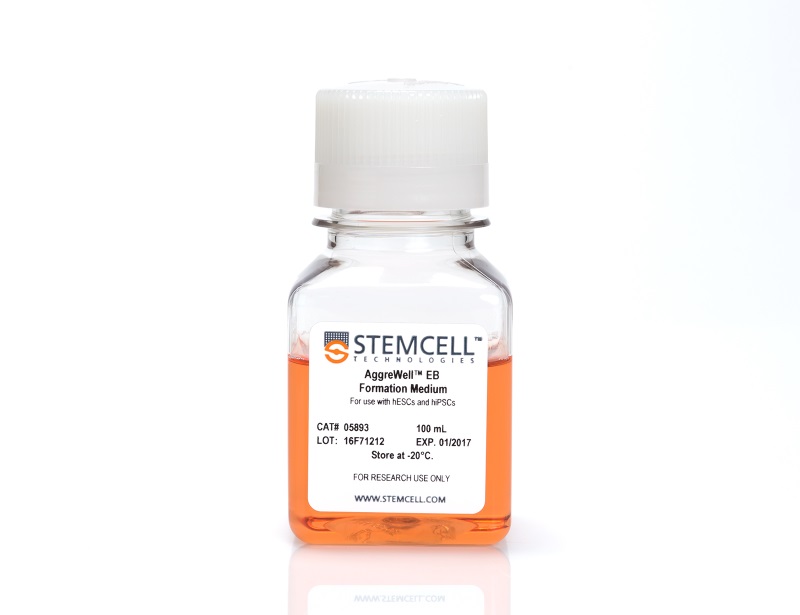AggreWell™ EB Formation Medium
Serum-free medium for generation and culture of embryoid bodies using AggreWell™ plates
概要
AggreWell™ EB Formation Medium is a serum-free medium that supports the survival of mTeSR™1-, TeSR™2-, or TeSR™-E8™-cultured human embryonic stem (ES) cells or human induced pluripotent stem (iPS) cells during generation and subsequent culture of embryoid bodies (EBs).
Subtype
Specialized Media
Cell Type
Pluripotent Stem Cells
Species
Human
Application
Differentiation
Brand
AggreWell
Area of Interest
Stem Cell Biology
Formulation
Serum-Free
技术资料
| Document Type | 产品名称 | Catalog # | Lot # | 语言 |
|---|---|---|---|---|
| Product Information Sheet | AggreWell™ EB Formation Medium | 05893 | All | English |
| Safety Data Sheet | AggreWell™ EB Formation Medium | 05893 | All | English |
数据及文献
Publications (6)
Biomaterials 2016 MAR
Fibromodulin reprogrammed cells: A novel cell source for bone regeneration.
Abstract
Abstract
Pluripotent or multipotent cell-based therapeutics are vital for skeletal reconstruction in non-healing critical-sized defects since the local endogenous progenitor cells are not often adequate to restore tissue continuity or function. However, currently available cell-based regenerative strategies are hindered by numerous obstacles including inadequate cell availability, painful and invasive cell-harvesting procedures, and tumorigenesis. Previously, we established a novel platform technology for inducing a quiescent stem cell-like stage using only a single extracellular proteoglycan, fibromodulin (FMOD), circumventing gene transduction. In this study, we further purified and significantly increased the reprogramming rate of the yield multipotent FMOD reprogrammed (FReP) cells. We also exposed the 'molecular blueprint' of FReP cell osteogenic differentiation by gene profiling. Radiographic analysis showed that implantation of FReP cells into a critical-sized SCID mouse calvarial defect, contributed to the robust osteogenic capability of FReP cells in a challenging clinically relevant traumatic scenario in vivo. The persistence, engraftment, and osteogenesis of transplanted FReP cells without tumorigenesis in vivo were confirmed by histological and immunohistochemical staining. Taken together, we have provided an extended potency, safety, and molecular profile of FReP cell-based bone regeneration. Therefore, FReP cells present a high potential for cellular and gene therapy products for bone regeneration.
PLoS ONE 2015 MAR
Reprogramming of HUVECs into induced pluripotent stem cells (HiPSCs), generation and characterization of HiPSC-derived neurons and astrocytes
Abstract
Abstract
Neurodegenerative diseases are characterized by chronic and progressive structural or functional loss of neurons. Limitations related to the animal models of these human diseases have impeded the development of effective drugs. This emphasizes the need to establish disease models using human-derived cells. The discovery of induced pluripotent stem cell (iPSC) technology has provided novel opportunities in disease modeling, drug development, screening, and the potential for patient-matched" cellular therapies in neurodegenerative diseases. In this study�
Oncogene 2015 JUN
Modeling the initiation of Ewing sarcoma tumorigenesis in differentiating human embryonic stem cells.
Abstract
Abstract
Oncogenic transformation in Ewing sarcoma tumors is driven by the fusion oncogene EWS-FLI1. However, despite the well-established role of EWS-FLI1 in tumor initiation, the development of models of Ewing sarcoma in human cells with defined genetic elements has been challenging. Here, we report a novel approach to model the initiation of Ewing sarcoma tumorigenesis that exploits the developmental and pluripotent potential of human embryonic stem cells. The inducible expression of EWS-FLI1 in embryoid bodies, or collections of differentiating stem cells, generates cells with properties of Ewing sarcoma tumors, including characteristics of transformation. These cell lines exhibit anchorage-independent growth, a lack of contact inhibition and a strong Ewing sarcoma gene expression signature. Furthermore, these cells also demonstrate a requirement for the persistent expression of EWS-FLI1 for cell survival and growth, which is a hallmark of Ewing sarcoma tumors.Oncogene advance online publication, 12 October 2015; doi:10.1038/onc.2015.368.
Biological & pharmaceutical bulletin 2015
A Simple Protocol for the Myocardial Differentiation of Human iPS Cells.
Abstract
Abstract
We have developed a simple protocol for inducing the myocardial differentiation of human induced pluripotent stem (iPS) cells. Human iPS cell-derived embryonic bodies (EBs) were treated with a combination of activin-A, bone morphogenetic protein-4 and wnt-3a for one day in serum-free suspension culture, and were subsequently treated with noggin for three days. Thereafter, the EBs were subjected to adherent culture in media with 5% serum. All EBs were differentiated into spontaneously beating EBs, which were identified by the presence of striated muscles in transmission electron microscopy and the expression of the specific cardiomyocyte markers, NKX2-5 and TNNT2. The beating rate of the beating EBs was decreased by treatment with a rapidly activating delayed rectifier potassium current (Ikr) channel blocker, E-4031, an Ikr trafficking inhibitor, pentamidin, and a slowly activating delayed rectifier potassium current (Iks) channel blocker, chromanol 293B, and was increased by treatment with a beta-receptor agonist, isoproterenol. At a low concentration, verapamil, a calcium channel blocker, increased the beating rate of the beating EBs, while a high concentration decreased this rate. These findings suggest that the spontaneously beating EBs were myocardial cell clusters. This simple protocol for myocardial differentiation would be useful in providing a sufficient number of the beating myocardial cell clusters for studies requiring human myocardium.
Stem Cell Research 2014 NOV
Src-family tyrosine kinase activities are essential for differentiation of human embryonic stem cells
Abstract
Abstract
Embryonic stem (ES) cells are characterized by pluripotency, defined as the developmental potential to generate cell lineages derived from all three primary germ layers. In the past decade, great progress has been made on the cell culture conditions, transcription factor programs and intracellular signaling pathways that control both murine and human ES cell fates. ES cells of mouse vs. human origin have distinct culture conditions, responding to some tyrosine kinase signaling pathways in opposite ways. Previous work has implicated the Src family of non-receptor protein-tyrosine kinases in mouse ES cell self-renewal and differentiation. Seven members of the Src kinase family are expressed in mouse ES cells, and individual family members appear to play distinct roles in regulating their developmental fate. Both Hck and c-Yes are important in self-renewal, while c-Src activity alone is sufficient to induce differentiation. While these findings implicate Src-family kinase signaling in mouse ES cell renewal and differentiation, the role of this kinase family in human ES cells is largely unknown. Here, we explored Src-family kinase expression patterns and signaling in human ES cells during self-renewal and differentiation. Of the eleven Src-related kinases in the human genome, Fyn, c-Yes, c-Src, Lyn, Lck and Hck were expressed in H1, H7 and H9 hES cells, while Fgr, Blk, Srm, Brk, and Frk transcripts were not detected. Of these, c-Yes, Lyn, and Hck transcript levels remained constant in self-renewing human ES cells vs. differentiated EBs, while c-Src and Fyn showed a modest increase in expression as a function of differentiation. In contrast, Lck expression levels dropped dramatically as a function of EB differentiation. To assess the role of overall Src-family kinase activity in human ES cell differentiation, cultures were treated with inhibitors specific for the Src kinase family. Remarkably, human ES cells maintained in the presence of the potent Src-family kinase inhibitor A-419259 retained the morphology of domed, pluripotent colonies and continued to express the self-renewal marker TRA-1-60 despite culture under differentiation conditions. Taken together, these observations support a role for Src-family kinase signaling in the regulation of human ES cell fate, and suggest that the activities of individual Src-family members are required for the initiation of the differentiation program.
Molecular Human Reproduction 2014 JUN
ONSL and OSKM cocktails act synergistically in reprogramming human somatic cells into induced pluripotent stem cells
Abstract
Abstract
The advent of human induced pluripotent stem cells (hiPSC) is revolutionizing many research fields including cell-replacement therapy, drug screening, physiopathology of specific diseases and more basic research such as embryonic development or diseases modeling. Despite the large number of reports on reprogramming methods, techniques in use remain globally inefficient. We present here a new optimized approach to improve this efficiency. After having tested different monocistronic vectors with poor results, we adopted a polycistronic cassette encoding Thomson's cocktail OCT4, NANOG, SOX2 and LIN28 (ONSL) separated by 2A peptides. This cassette was tested in various vector backbones, based on lentivirus or retrovirus under a LTR or EF1 alpha promoter. This allowed us to show that ONSL-carrier retrovectors reprogrammed adult fibroblast cells with a much higher efficiency (up to 0.6%) than any other tested. We then compared the reprogramming efficiencies of two different polycistronic genes, ONSL and OCT4, SOX2, KLF4 and cMYC (OSKM) placed in the same retrovector backbone. Interestingly, in this context ONSL gene reprograms more efficiently than OSKM but OSKM reprograms faster suggesting that the two cocktails may reprogram through distinct pathways. By equally mixing RV-LTR-ONSL and RV-LTR-OSKM, we indeed observed a remarkable synergy, yielding a reprogramming efficiency of textgreater2%. We present here a drastic improvement of the reprogramming efficiency, which opens doors to the development of automated and high throughput strategies of hiPSC production. Furthermore, non-integrative reprogramming protocols (i.e. mRNA) may take advantage of this synergy to boost their efficiency.


